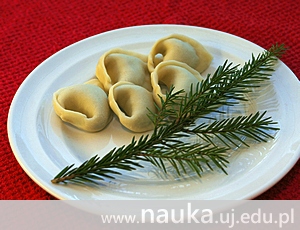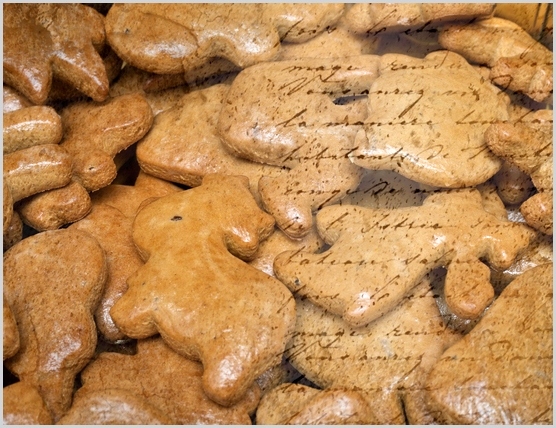
What are the origins of twelve Christmas Eve dishes? What does it mean that fish used to be served “in grey sauce”? What was eaten in different parts of Poland? We asked Dr hab. Tadeusz Czekalski from the JU Institute of History about the culinary traditions related to the Polish Christmas Eve.
Kamil Kopij: The Polish Christmas Eve dinner traditionally consisted of twelve dishes. Not all Poles observe this custom, but it is still alive in a symbolic sense. Where did it come from?
Dr hab. Tadeusz Czekalski: A Christmas Eve dinner used to be prepared in accordance with religious principles, but also with the rules of magic, including numerology. Observing rules, including those related to the number of dishes and places at the table was aimed at ensuring divine protection and the family’s well being during the following year.
Carp in grey sauce
Blood was let from several living carps and mixed with wine vinegar. Parsley and onion were fried in butter, pressed through a sieve and cooked with the carp and blood mixed with vinegar. Wine, sugar, pepper, cinnamon, and cloves were also added (other variants included gingerbread, honey, almonds and/or raisins – editor’s note).
Source: Andrzej Moraczewski and Emil Kierski, Starożytności Polskie (Polish antiquities), 1842.
The most often mentioned number of twelve dishes clearly refers both to the number of months in a year and the number of apostles. In the past, more emphasis was placed on an odd number of dishes. In rich families, there were as many as eleven of them, whereas many peasants could only afford five or seven dishes.
Carp, cabbage, beet borscht with dumplings – these are dishes usually associated with the Polish Christmas Eve. What was it like in the past?
The Christmas Eve menu reflects the season in which vegetation stops and cuisine is based on what has been stored in larders. To prevent any food shortages in the year to follow, the Christmas Eve dishes had to include products from the field, forest, orchard and water. The dominant role of borscht on the Christmas eve table is undeniable, but in 19th-century Kraków almond soup and wild mushroom soup were equally popular, whereas sour oat soup with mushrooms or sour rye soup with oat bran were most widespread in the surrounding countryside.
Fish dishes formed the basis of Christmas Eve dinner. Depending on the wealth of the household, peasant families prepared herrings or limited themselves to dishes based on flour, milk and linseed. Among nobility, it was carp, pike and sander that reigned supreme at the Christmas Eve dinner. Fishes served “grey-style” – in a sauce made, among other ingredients, of fish blood, gingerbread and caramel – are an example of a dish typical of traditional Polish cuisine. Besides the highly valued fishes, Christmas Eve dinner could include dishes made of perch, tench and the earlier mentioned herring. The dinner concluded with poppy seed and honey dishes, and, depending on the region, a sweet cereal dish called kutia, or various sorts of pie. Poorer families had to make do with dishes made of peas, beans, and cabbage.

To what extent did Christmas Eve culinary traditions vary from region to region?
One of the culinary effects of the partitions of Poland1 is a separate set of Christmas Eve dishes, characteristic of different region of the country. Specific dishes can be found under different names and in different variants, but there are also some dishes typical of particular regions. In 19th-century Wrocław, a soup with roe was traditionally followed by a carp with horseradish or in beer sauce. A gingerbread or parsnip soups called moczka and siemienotka are typical of the Silesian Christmas Eve dinner. This region is also known for fish head soup. In poor Kaszubian houses, no poppy seed was used, and Christmas Eve dishes included herring soup with vinegar and pies baked with oil, known as pampuchy. Mazovian Christmas Eve cuisine was characterised by Eastern-style dumplings and racuchy (which are similar to pancakes), as well as dried fruit soup.
Looking back into the past, it should be noticed that, irrespective of regional differences, there were three ingredients which played a special role in Christmas Eve dishes, due to the special powers attributed to them. These unique products were poppy seed, wheat grain and honey. In the winder period, when life cycle was “halted”, poppy seed was a sign of abundance, grain symbolised new life being born, whereas honey was treated as a medicine. These ingredients heralded the upcoming re-birth of nature, combined with the hope for family’s good fortune and prosperity in the year to come.
Original text: www.nauka.uj.edu.pl
----------------------
1 In the late 18th century, Poland lost its independence and its territories were divided between Russia, Prussia and Austria. The country regained independence in 1918.





